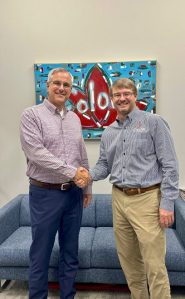Isaac Newton
Published 1:28 pm Friday, August 12, 2022
And God said, Let there be light: and there was light. So begins the creation story from the King James Book of Genesis, verse 3. Light begins with stars, so God might just as well have said let there be stars. The astronomer’s search begins with light, so the gift of light is a gift of knowledge. As we shall see, there is more to light than meets the eye.
Isaac Newton was born on Christmas Day, 1642, by the Julian calendar of the day, and on January 4, 1643, by today’s Gregorian calendar. His father, also named Isaac, died three months before Isaac’s birth. His mother, Hannah Ayscough, remarried and left Isaac in the care of her mother. Hannah widowed a second time and made Isaac a farmer, an occupation he despised. Isaac’s schoolmaster convinced Hannah to let him return to school. He was an excellent student and went to Trinity College, Cambridge, where he became a mediocre student but graduated. Soon thereafter, Cambridge was temporarily closed due to the Great Plague. Later, Newton’s private studies resulted in groundbreaking advancements in mathematics, optics, gravity, and physics.
Trending
Newton became famous during his lifetime but remained modest. He wrote, “I do not know what I may appear to the world, but to myself I seem to have been only like a boy playing on the sea-shore, and diverting myself in now and then finding a smoother pebble or a prettier shell than ordinary, whilst the great ocean of truth lay all undiscovered before me.” Later, the English poet Alexander Pope wrote “nature and Nature’s laws lay hid in night: God said, Let Newton be! And all was light.” And so, we return the gift of light.
We’ve all seen the beautiful colors of light passing through faceted glass on the wall or floor or a beautiful rainbow from light passing through raindrops. In searching for the great ocean of undiscovered truth, Newton began experimenting with this colorful light and called it a spectrum. He demonstrated that a spectrum passed through a lens and a second prism could be reassembled into white light. He realized the spectrum is not colors introduced by the prism material, but that light itself is composed of all these colors.
A century later, the German scientist Joseph Ritter von Fraunhofer developed the spectroscope, an instrument for closely examining a spectrum. In his instrument, sunlight revealed not only beautiful colors but many dark lines of various frequencies and spacings. Each burning chemical element, or each gas that light passes through, leaves a fingerprint. By the time of the American Civil War, scientists had recorded the fingerprint of each element. Sunlight contained a fingerprint of an element unknown on Earth. It was Helium, the second most abundant element in the universe. Helium is rare on Earth because it easily escapes our atmosphere.
Light tells us much more than which element burned it. To the careful astronomer, light reveals many secrets of the universe. Thank God for light and Newton also.






